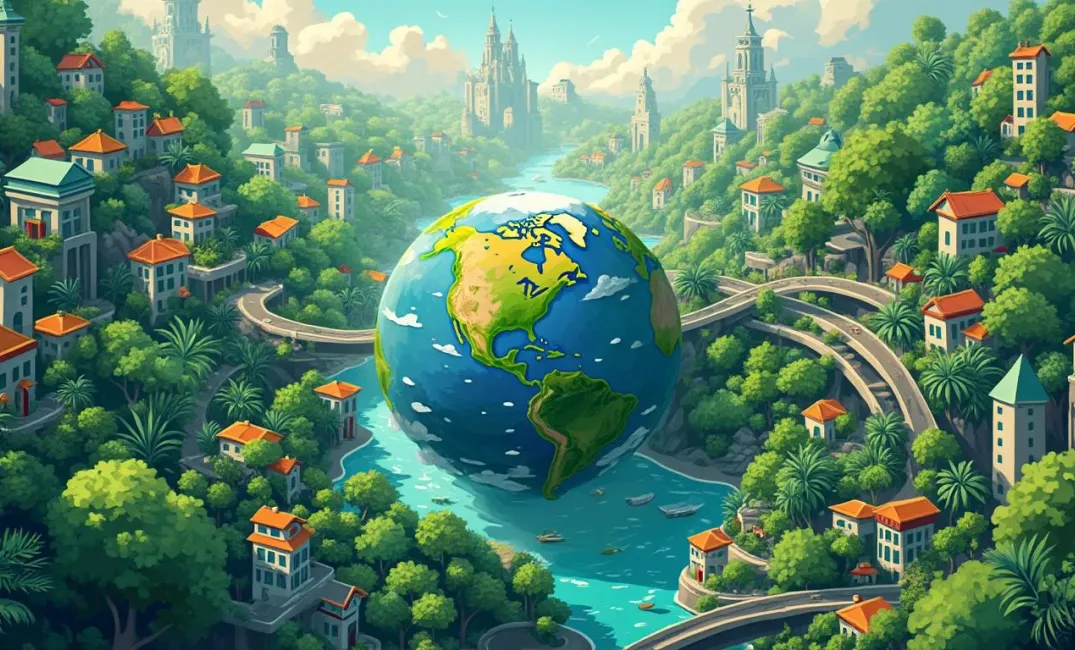Introduction: Interweaving Lives and Habitats
"Nature does not hurry, yet everything is accomplished." — Lao Tzu
Humanity’s history has been intertwined with the natural world, drawing sustenance, inspiration, and challenges from diverse ecosystems that span the globe. From the verdant rainforests to the arid deserts, the relationship between humans and their environments has shaped civilizations, philosophies, and technological advancement. As humanity contemplates extending life beyond Earth, deepening our understanding of ecosystems becomes critical. This entry explores the intricate harmony of the natural world and the profound lessons it offers for sustainable futures.
The Tapestry of Earth's Ecosystems: Diversity and Interdependence
Ecosystem Complexity and Connection
- Biodiversity's Web: Earth's ecosystems are defined by a rich tapestry of life, each organism interlinked in a web that supports varying layers of existence. This biodiversity is not merely scenic but vital for ecosystem services—purification, pollination, climate regulation—that life relies upon.
- Interdependent Systems: Ecosystems are characterized by complex interdependencies. The roles of keystone species, such as the beaver in constructing wetlands or bees in pollinating flora, highlight the balance and connectivity between species and their habitats.
Resilience and Adaptation
- Nature's Resilience: Ecosystems demonstrate remarkable resilience, revealing adaptation strategies in response to environmental fluctuations. Coral reefs, despite facing bleaching and acidic seas, highlight resilience through some species’ adaptive symbiosis and gene variations.
- Adaptive Mechanisms: Evolution provides ecosystems with adaptive mechanisms—migration, genetic diversity, maturation—that serve as biological insurance against an ever-changing environment and offer insight into adaptability for human challenges.
Humanity's Impact: A Double-Edged Sword
Anthropogenic Influence
- Environmental Alterations: Human activities have dramatically reshaped natural ecosystems, with deforestation, resource extraction, and urban development disrupting ecological harmony. The Amazon rainforest is a poignant example of human encroachment impacting climate and biodiversity.
- Climate Change Dialogues: Greenhouse gas emissions have accelerated climate change, altering habitats and prompting shifts in species distribution and survival. Contemporary narratives emphasize legislative action, innovation, and global cooperation to mitigate climate impacts.
Lessons from Indigenous Wisdom
- Holistic Management: Indigenous cultures have long understood the ecosystems' intricacies, practicing sustainable land management and conservation that reflects deep-seated ecological and spiritual wisdom. The agroecological practices of the Maya and Polynesian voyaging navigators highlight this profound harmony.
- Cultural Biodiversity: Cultivating species and practices to suit unique environments signifies the botanical and ecological knowledge embedded within indigenous systems, respectful of nature’s limits and regenerative capacities.
Technological Innovation: Bridging Nature and Human Progress
Advancements in Ecological Science
- Ecosystem Modelling: Modern ecological science utilizes technology and models to simulate ecosystem dynamics, predicting outcomes and crafting interventions reflective of ecosystem needs and human impact scenarios.
- Conservation Technology: Innovations such as satellite monitoring, drones, and genetic tools extend conservation efforts, enhancing data acquisition for species management, habitat restoration, and combating poaching.
Urban Planning and Green Architecture
- Sustainable Design Principles: Biophilic design and urban ecosystems integrate nature into urban landscapes, promoting both ecological health and human well-being. Green roofs and living walls exemplify this convergence.
- Circular Economies: Ecological conservation is furthered by implementing sustainable economic frameworks that emphasize resource regeneration, reduced waste, and conservation-driven initiatives.
Lessons from Nature: Guiding Ecological Harmony
Nature-Inspired Solutions
- Biomimicry in Engineering: Solutions that mimic nature hold potential for innovative breakthroughs. From the aerodynamic efficiency inspired by bird wings to the water conservation strategies modeled after desert flora, nature’s ingenuity informs sustainable human design.
- Ecosystem Restoration: Restoration ecology showcases nature’s capacity for renewal. Efforts such as rewilding and wetland restoration demonstrate the potential for ecosystems to recover from degradation, underscoring resilience and echoing lessons of sustainability.
Collaborative Conservation
- Global Initiatives and Alliances: Alliance-driven conservation efforts emphasize collaboration. Programs like the Convention on Biological Diversity (CBD) advocate for planetary stewardship, linking environmental commitments to cultural and economic practices.
- Community-Led Conservation: Empowering local communities to steward natural resources reflects a respect for their environmental knowledge. Collaborative community projects have successfully protected habitats while enhancing social cohesion and livelihoods.
Conclusion: A Blueprint for Sustainable Futures
"In every walk with nature, one receives far more than he seeks." — John Muir
Earth’s ecosystems serve as both sanctuary and mentor, revealing the synergy of life woven into the fabric of the natural world. The lessons from these environments—resilience, adaptation, interconnectedness—are not mere echoes but blueprints guiding humanity’s aspirations for harmony and sustainability. As we look beyond Earth, these principles form the foundational ethos of future engagements with new worlds.
In the vast orchestra of existence, let our continued exploratory endeavors be informed by the melodies of nature, resonating through history and guiding the stewardship of life’s immense potential across stars. Through conservation and exploration, humanity can harmoniously bridge the wonders of Earth's cradles and the boundless universes awaiting our shared journey.
ECOSYSTEMS, SUSTAINABILITY, BIODIVERSITY, INDIGENOUS KNOWLEDGE, ANTHROPOLOGY, CONSERVATION, TECHNOLOGY, CLIMATE CHANGE, RESILIENCE, BIOMIMICRY

